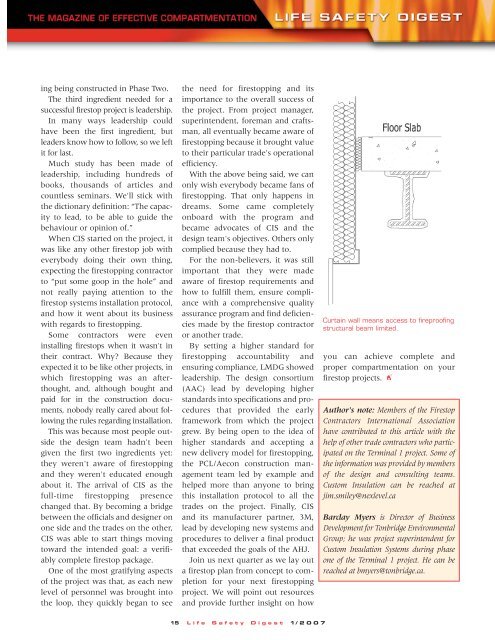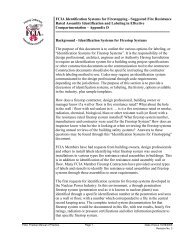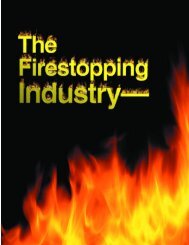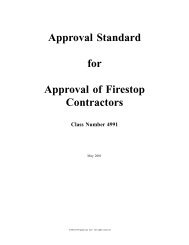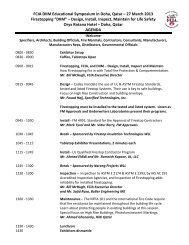Winter 2007 - FCIA - Firestop Contractors International Association
Winter 2007 - FCIA - Firestop Contractors International Association
Winter 2007 - FCIA - Firestop Contractors International Association
Create successful ePaper yourself
Turn your PDF publications into a flip-book with our unique Google optimized e-Paper software.
ing being constructed in Phase Two.<br />
The third ingredient needed for a<br />
successful firestop project is leadership.<br />
In many ways leadership could<br />
have been the first ingredient, but<br />
leaders know how to follow, so we left<br />
it for last.<br />
Much study has been made of<br />
leadership, including hundreds of<br />
books, thousands of articles and<br />
countless seminars. We'll stick with<br />
the dictionary definition: “The capacity<br />
to lead, to be able to guide the<br />
behaviour or opinion of.”<br />
When CIS started on the project, it<br />
was like any other firestop job with<br />
everybody doing their own thing,<br />
expecting the firestopping contractor<br />
to “put some goop in the hole” and<br />
not really paying attention to the<br />
firestop systems installation protocol,<br />
and how it went about its business<br />
with regards to firestopping.<br />
Some contractors were even<br />
installing firestops when it wasn't in<br />
their contract. Why Because they<br />
expected it to be like other projects, in<br />
which firestopping was an afterthought,<br />
and, although bought and<br />
paid for in the construction documents,<br />
nobody really cared about following<br />
the rules regarding installation.<br />
This was because most people outside<br />
the design team hadn't been<br />
given the first two ingredients yet:<br />
they weren't aware of firestopping<br />
and they weren't educated enough<br />
about it. The arrival of CIS as the<br />
full-time firestopping presence<br />
changed that. By becoming a bridge<br />
between the officials and designer on<br />
one side and the trades on the other,<br />
CIS was able to start things moving<br />
toward the intended goal: a verifiably<br />
complete firestop package.<br />
One of the most gratifying aspects<br />
of the project was that, as each new<br />
level of personnel was brought into<br />
the loop, they quickly began to see<br />
the need for firestopping and its<br />
importance to the overall success of<br />
the project. From project manager,<br />
superintendent, foreman and craftsman,<br />
all eventually became aware of<br />
firestopping because it brought value<br />
to their particular trade's operational<br />
efficiency.<br />
With the above being said, we can<br />
only wish everybody became fans of<br />
firestopping. That only happens in<br />
dreams. Some came completely<br />
onboard with the program and<br />
became advocates of CIS and the<br />
design team's objectives. Others only<br />
complied because they had to.<br />
For the non-believers, it was still<br />
important that they were made<br />
aware of firestop requirements and<br />
how to fulfill them, ensure compliance<br />
with a comprehensive quality<br />
assurance program and find deficiencies<br />
made by the firestop contractor<br />
or another trade.<br />
By setting a higher standard for<br />
firestopping accountability and<br />
ensuring compliance, LMDG showed<br />
leadership. The design consortium<br />
(AAC) lead by developing higher<br />
standards into specifications and procedures<br />
that provided the early<br />
framework from which the project<br />
grew. By being open to the idea of<br />
higher standards and accepting a<br />
new delivery model for firestopping,<br />
the PCL/Aecon construction management<br />
team led by example and<br />
helped more than anyone to bring<br />
this installation protocol to all the<br />
trades on the project. Finally, CIS<br />
and its manufacturer partner, 3M,<br />
lead by developing new systems and<br />
procedures to deliver a final product<br />
that exceeded the goals of the AHJ.<br />
Join us next quarter as we lay out<br />
a firestop plan from concept to completion<br />
for your next firestopping<br />
project. We will point out resources<br />
and provide further insight on how<br />
Curtain wall means access to fireproofing<br />
structural beam limited.<br />
you can achieve complete and<br />
proper compartmentation on your<br />
firestop projects.<br />
Author's note: Members of the <strong>Firestop</strong><br />
<strong>Contractors</strong> <strong>International</strong> <strong>Association</strong><br />
have contributed to this article with the<br />
help of other trade contractors who participated<br />
on the Terminal 1 project. Some of<br />
the information was provided by members<br />
of the design and consulting teams.<br />
Custom Insulation can be reached at<br />
jim.smiley@nexlevel.ca<br />
Barclay Myers is Director of Business<br />
Development for Tonbridge Environmental<br />
Group; he was project superintendent for<br />
Custom Insulation Systems during phase<br />
one of the Terminal 1 project. He can be<br />
reached at bmyers@tonbridge.ca.<br />
15 Life Safety Digest 1/<strong>2007</strong>


